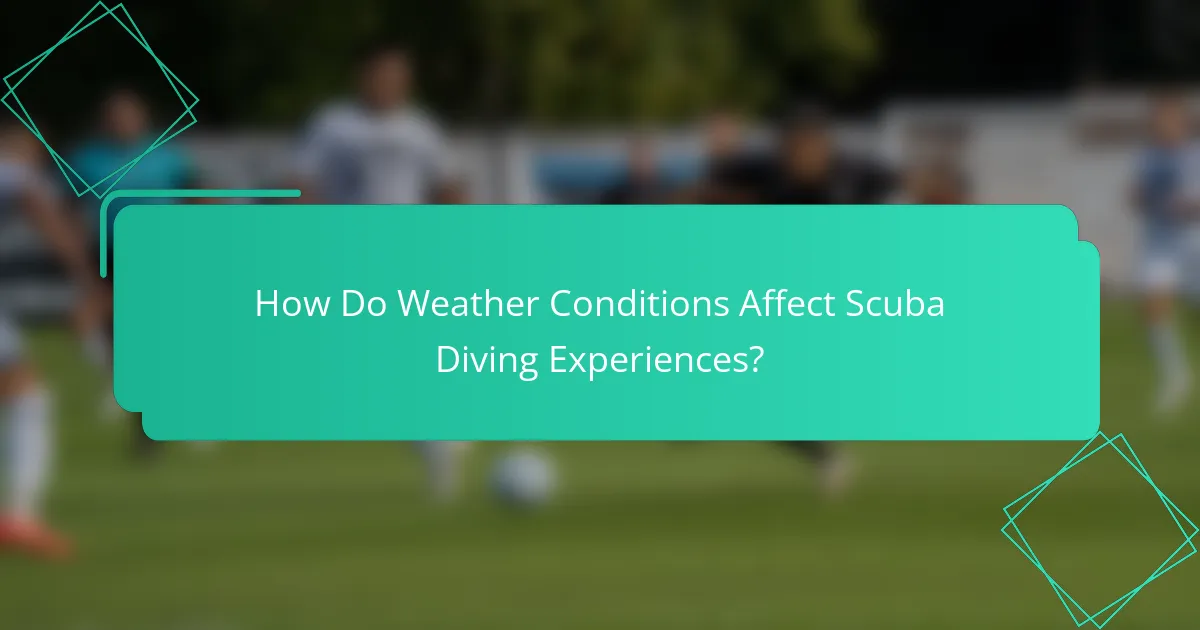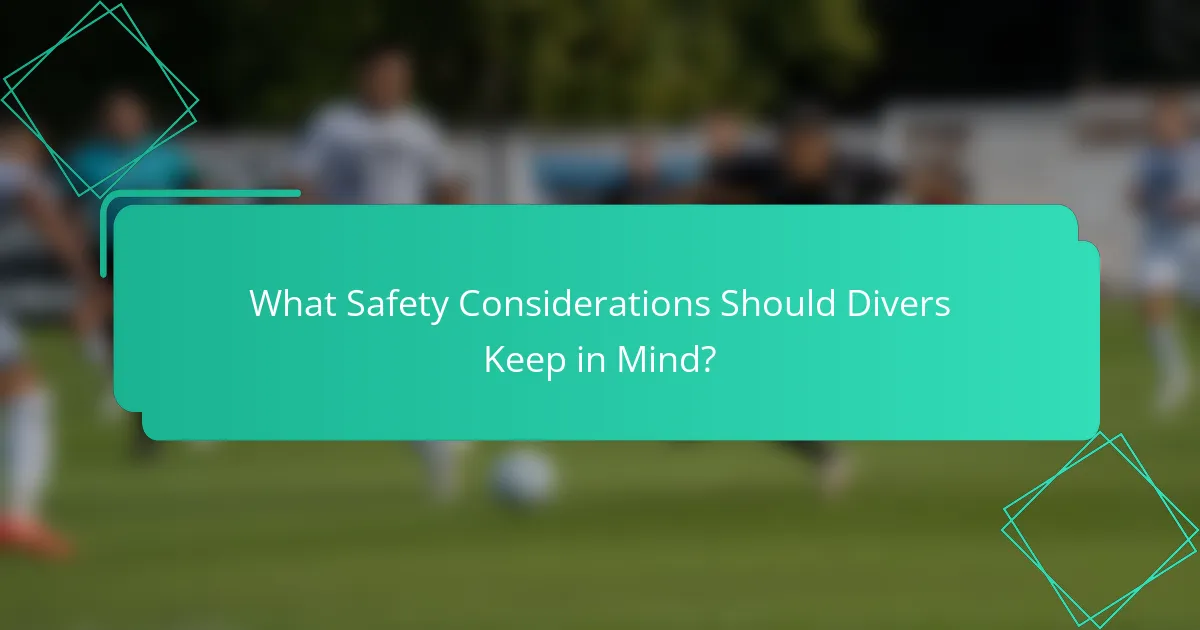Exploring the world’s best scuba diving destinations reveals diverse marine life, varying dive conditions, and essential equipment needs. Discover the unique ecosystems of the Great Barrier Reef, the Red Sea, and the Maldives. Understand how weather impacts your diving experience and learn about the crucial gear required for safety and comfort underwater. Prioritise sustainable practices to protect these vibrant underwater environments while enjoying your dives.

What are the Top Scuba Diving Destinations Around the World?
The top scuba diving destinations around the world include the Great Barrier Reef, the Red Sea, and the Maldives. Each offers unique marine life, varying dive conditions, and specific equipment needs for divers.
The Great Barrier Reef in Australia is renowned for its biodiversity, featuring over 1,500 species of fish and extensive coral formations. Ideal dive conditions occur from June to November, with visibility often exceeding 30 metres. Divers typically require a wetsuit, reef-safe sunscreen, and standard scuba gear.
The Red Sea, especially around Sharm El Sheikh, showcases vibrant coral reefs and diverse marine species, including sharks and turtles. The best diving conditions are from April to June and September to November. Essential equipment includes a shorty wetsuit and dive computer.
The Maldives boasts stunning atolls with rich marine life, including manta rays and whale sharks. The optimal diving season is from November to April, with calm seas and excellent visibility. Divers should bring a full wetsuit and underwater camera to capture the breathtaking scenery.
Which Regions Offer the Most Diverse Marine Life?
The regions offering the most diverse marine life include the Coral Triangle, the Great Barrier Reef, and the Red Sea. These areas boast unique ecosystems, vibrant coral reefs, and a high variety of species.
The Coral Triangle, located in Southeast Asia, is known for its 600+ coral species and 3,000+ fish species. The Great Barrier Reef in Australia is the world’s largest coral reef system, supporting over 1,500 fish species. The Red Sea, with its unique geographical features, is home to around 1,200 species of fish, including many endemic species.
These destinations provide exceptional scuba diving experiences, showcasing the richness of marine biodiversity.
What Unique Marine Species Can Be Found in Specific Locations?
Unique marine species can be found in specific locations worldwide. For example, the Great Barrier Reef hosts the clownfish, while the Galápagos Islands are home to the marine iguana. The Red Sea boasts the manta ray, and the Caribbean features the seahorse. Each location offers distinct dive conditions and unique marine life, enhancing the scuba diving experience.

How Do Weather Conditions Affect Scuba Diving Experiences?
Weather conditions significantly impact scuba diving experiences by influencing visibility, water temperature, and marine life activity. For example, calm seas enhance visibility, while strong currents can make diving challenging. Rain and storms may reduce visibility and affect marine life behaviour. Optimal diving occurs in stable weather, typically during dry seasons. Understanding local weather patterns helps divers choose the best times for their dives, ensuring safety and enjoyment.
What are the Ideal Seasons for Diving in Various Destinations?
The ideal seasons for diving vary by destination, influenced by marine life activity and weather conditions.
| Destination | Ideal Season | Marine Life Highlights | Dive Conditions | Equipment Needs |
|———————|——————-|——————————–|————————|————————-|
| Great Barrier Reef | June to November | Manta rays, turtles | Calm waters, good visibility | Wetsuit, dive computer |
| Maldives | November to April | Whale sharks, vibrant corals | Warm waters, clear visibility | Light wetsuit, reef hook |
| Red Sea | March to May, September to November | Diverse fish species, wrecks | Moderate currents, good visibility | Wetsuit, dive light |
| Caribbean | December to April | Tropical fish, sharks | Warm waters, variable visibility | Light wetsuit, dive knife |
| Thailand | November to April | Colourful reefs, turtles | Calm conditions, good visibility | Wetsuit, underwater camera |
How Do Water Temperatures Influence Dive Conditions?
Water temperatures significantly influence dive conditions by affecting marine life behaviour and visibility. Warmer waters often attract diverse species, enhancing the diving experience. Conversely, colder temperatures may limit visibility and require specialised equipment. For instance, tropical destinations typically feature temperatures ranging from 24°C to 29°C, promoting vibrant marine ecosystems. In contrast, polar regions may have temperatures below 10°C, necessitating thicker wetsuits or drysuits. Understanding these temperature variations helps divers select suitable locations and prepare adequately for their dive adventures.

What Equipment is Essential for Scuba Diving?
Essential scuba diving equipment includes a mask, snorkel, fins, wetsuit, buoyancy control device (BCD), regulator, and tank. Each component plays a critical role in ensuring safety and comfort underwater.
1. Mask: Provides visibility underwater, typically made of tempered glass for durability.
2. Snorkel: Allows for breathing at the surface without lifting the head.
3. Fins: Enhance propulsion and manoeuvrability in the water.
4. Wetsuit: Offers thermal protection; thickness varies based on water temperature.
5. Buoyancy Control Device (BCD): Helps divers manage buoyancy and provides storage for gear.
6. Regulator: Delivers air from the tank to the diver, crucial for breathing underwater.
Selecting the right equipment is vital for a safe and enjoyable diving experience.
Which Types of Diving Gear are Recommended for Beginners?
Recommended diving gear for beginners includes a mask, snorkel, fins, wetsuit, and buoyancy control device. A well-fitting mask enhances visibility while snorkelling. Fins improve propulsion and efficiency in the water. A wetsuit provides thermal protection in varying water temperatures. A buoyancy control device aids in maintaining neutral buoyancy, essential for safe diving. Each piece of gear is crucial for comfort and safety during initial diving experiences.
How Does Equipment Quality Impact Safety and Experience?
Equipment quality significantly impacts safety and experience in scuba diving. High-quality gear ensures reliable performance, reducing risks associated with equipment failure. For instance, well-constructed regulators and buoyancy control devices enhance diver control and comfort, contributing to an overall positive diving experience. Additionally, using equipment that meets safety standards minimises the likelihood of accidents. In contrast, subpar gear can lead to complications, such as equipment malfunctions or inadequate buoyancy, jeopardising diver safety and enjoyment. Investing in quality equipment is essential for a safe and enjoyable scuba diving experience.

What Safety Considerations Should Divers Keep in Mind?
Divers should prioritise safety by following guidelines specific to their dive location and conditions. Key considerations include understanding local marine life, assessing dive conditions, and ensuring proper equipment is used. Familiarity with potential hazards, such as strong currents or marine species, enhances safety. Additionally, divers should maintain clear communication with their dive team and stay within their skill level. Regular equipment checks before diving prevent malfunctions underwater, ensuring a safer experience.
How Can Divers Prepare for Emergency Situations?
Divers can prepare for emergency situations by understanding dive conditions, mastering equipment usage, and practising safety protocols. Key steps include regular training, checking equipment before dives, and planning for emergency exits. Familiarity with local marine life helps divers recognise potential hazards. Additionally, having a first aid kit and emergency communication devices enhances safety during dives.
What are the Most Common Risks Associated with Scuba Diving?
The most common risks associated with scuba diving include decompression sickness, barotrauma, and marine life encounters. Decompression sickness occurs when a diver ascends too quickly, causing nitrogen bubbles to form in the bloodstream. Barotrauma results from pressure changes affecting air spaces in the body, often leading to ear or lung injuries. Encounters with marine life can lead to injuries from bites or stings, particularly from jellyfish or aggressive fish species. Proper training, equipment, and awareness of dive conditions can mitigate these risks significantly.

How Do Dive Regulations Vary by Destination?
Dive regulations vary significantly by destination, influenced by local marine ecosystems and safety standards. Some regions enforce strict limits on the number of divers per site to protect fragile marine life, while others may have more lenient rules. For instance, the Great Barrier Reef has specific guidelines to minimise environmental impact, whereas tropical destinations like the Caribbean may focus more on diver safety and training requirements. Each location’s regulations can also dictate permitted equipment, dive depths, and necessary certifications, ensuring divers adhere to local conservation efforts.
What Certifications Are Required for Diving in Different Regions?
Diving certifications vary by region and are essential for safe scuba diving. Common certifications include PADI Open Water Diver, SSI Open Water Diver, and NAUI Scuba Diver. Each region may have specific requirements based on local dive conditions and marine life.
| Region | Common Certification | Unique Requirement | Dive Conditions |
|—————–|——————————-|———————————|————————————-|
| Caribbean | PADI Open Water Diver | Local marine life awareness | Warm waters, diverse marine life |
| Southeast Asia | SSI Open Water Diver | Knowledge of currents | Tropical reefs, variable visibility |
| Europe | NAUI Scuba Diver | Depth limits for cold waters | Cold waters, limited visibility |
| Australia | PADI Advanced Open Water Diver | Knowledge of local fauna | Strong currents, diverse ecosystems |
| North America | NAUI Advanced Scuba Diver | Certification for wreck diving | Varied conditions, freshwater options |
How Do Local Laws Impact Diving Practices?
Local laws significantly influence diving practices by regulating marine conservation, safety standards, and equipment usage. These regulations ensure the protection of marine ecosystems and promote safe diving experiences. For instance, some regions require specific permits for diving in protected areas, while others may mandate the use of certain equipment to minimise environmental impact. Additionally, local laws can dictate dive site accessibility and operational hours, affecting divers’ planning and safety. Understanding these regulations is crucial for divers to ensure compliance and enhance their diving experience.

What are the Best Practices for Sustainable Diving?
To practise sustainable diving, choose eco-friendly dive operators, minimise contact with marine life, and avoid single-use plastics. Respect local regulations and participate in conservation efforts. Educate yourself and fellow divers on marine ecosystems’ importance.
| Best Practices | Description |
|—————-|————-|
| Eco-friendly operators | Select dive companies that prioritise sustainability. |
| Minimise contact | Avoid touching or disturbing marine life. |
| Avoid plastics | Use reusable containers and gear. |
| Follow regulations | Abide by local laws protecting marine environments. |
| Conservation participation | Engage in local clean-up or awareness activities. |
| Education | Stay informed about marine ecosystems and their preservation. |
How Can Divers Minimise Their Environmental Impact?
Divers can minimise their environmental impact by following sustainable practices. First, choose eco-friendly dive operators that prioritise conservation. Next, avoid touching or disturbing marine life and refrain from collecting souvenirs. Use biodegradable sunscreen to protect coral reefs. Additionally, practise proper buoyancy control to prevent damage to the ocean floor. Finally, participate in local clean-up efforts to help maintain dive sites.
What Role Do Dive Operators Play in Conservation Efforts?
Dive operators play a crucial role in conservation efforts by promoting sustainable practices and protecting marine ecosystems. They educate divers on environmental responsibility and often participate in local conservation projects. Many operators collaborate with marine research organisations to monitor biodiversity and assess the health of coral reefs. Additionally, they may implement measures to reduce the impact of diving activities, such as limiting the number of divers in sensitive areas. This commitment to conservation not only benefits marine life but also enhances the overall diving experience for tourists.
What Tips Can Enhance Your Scuba Diving Experience?
To enhance your scuba diving experience, focus on selecting the right destinations, understanding marine life, and ensuring proper equipment.
1. Research dive sites for unique marine life, like coral reefs or shipwrecks.
2. Check dive conditions, including water temperature and visibility, for safety.
3. Invest in quality equipment, such as a wetsuit suited for local conditions.
4. Consider guided dives to learn from experienced instructors and explore new areas.


